三年级下册英语第一节课
- 格式:ppt
- 大小:8.01 MB
- 文档页数:11
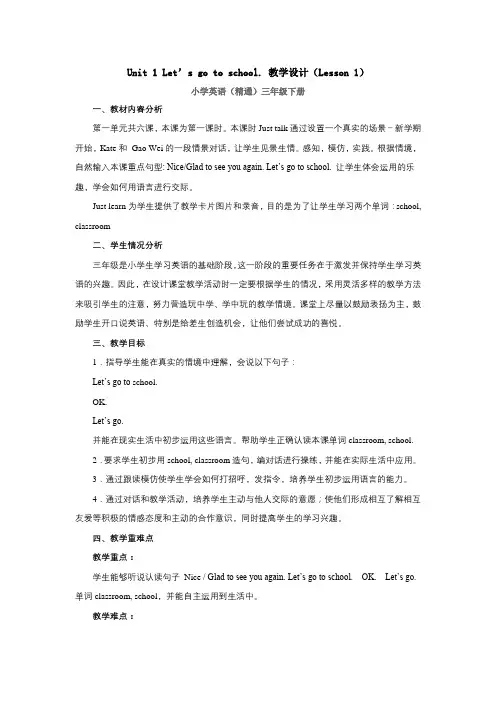
Unit 1 Let’s go to school. 教学设计(Lesson 1)小学英语(精通)三年级下册一、教材内容分析第一单元共六课,本课为第一课时。
本课时Just talk通过设置一个真实的场景-新学期开始,Kate和Gao Wei的一段情景对话,让学生见景生情。
感知,模仿,实践。
根据情境,自然输入本课重点句型: Nice/Glad to see you again. Let’s go to school. 让学生体会运用的乐趣,学会如何用语言进行交际。
Just learn为学生提供了教学卡片图片和录音,目的是为了让学生学习两个单词:school, classroom二、学生情况分析三年级是小学生学习英语的基础阶段,这一阶段的重要任务在于激发并保持学生学习英语的兴趣。
因此,在设计课堂教学活动时一定要根据学生的情况,采用灵活多样的教学方法来吸引学生的注意,努力营造玩中学、学中玩的教学情境。
课堂上尽量以鼓励表扬为主,鼓励学生开口说英语、特别是给差生创造机会,让他们尝试成功的喜悦。
三、教学目标1.指导学生能在真实的情境中理解,会说以下句子:Let’s go to school.OK.Let’s go.并能在现实生活中初步运用这些语言。
帮助学生正确认读本课单词classroom, school.2.要求学生初步用school, classroom造句,编对话进行操练,并能在实际生活中应用。
3.通过跟读模仿使学生学会如何打招呼,发指令,培养学生初步运用语言的能力。
4.通过对话和教学活动,培养学生主动与他人交际的意愿;使他们形成相互了解相互友爱等积极的情感态度和主动的合作意识,同时提高学生的学习兴趣。
四、教学重难点教学重点:学生能够听说认读句子Nice / Glad to see you again. Let’s go to school. OK. Let’s go. 单词classroom, school,并能自主运用到生活中。
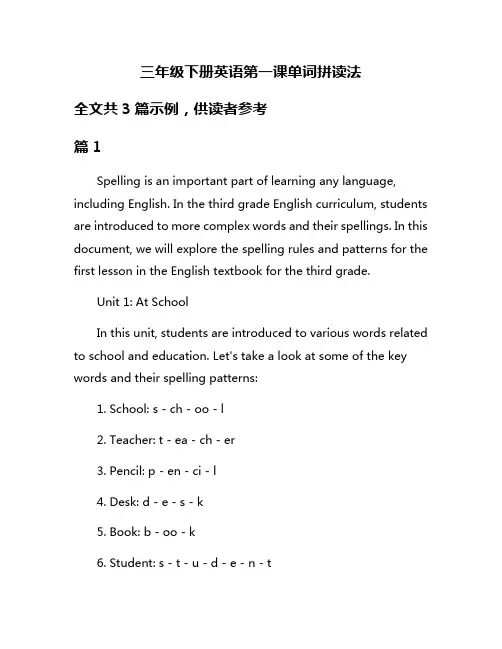
三年级下册英语第一课单词拼读法全文共3篇示例,供读者参考篇1Spelling is an important part of learning any language, including English. In the third grade English curriculum, students are introduced to more complex words and their spellings. In this document, we will explore the spelling rules and patterns for the first lesson in the English textbook for the third grade.Unit 1: At SchoolIn this unit, students are introduced to various words related to school and education. Let's take a look at some of the key words and their spelling patterns:1. School: s - ch - oo - l2. Teacher: t - ea - ch - er3. Pencil: p - en - ci - l4. Desk: d - e - s - k5. Book: b - oo - k6. Student: s - t - u - d - e - n - t7. Classroom: c - l - a - ss - r - oo - mStudents can practice spelling these words by breaking them down into syllables and practicing each syllable separately. Understanding the sound-letter correspondence is important in mastering the spelling of these words.Additionally, students can use mnemonic devices or visual aids to help them remember the spellings of these words. For example, they can create flashcards with the word on one side and a picture related to the word on the other side. This can help reinforce the spelling of the word in their memory.Practicing spelling these words in context is also important. Students can write sentences using these words or participate in spelling bees to test their knowledge and retention of the spelling patterns.Overall, mastering the spelling of these words is a crucial step in developing strong English language skills. By understanding the spelling rules and patterns for these words, students can improve their reading, writing, and communication skills. With practice and dedication, students can become confident spellers and effective communicators in English.篇2Title: Spelling Rules for the First Lesson of the Third Grade English BookIn the first lesson of the third-grade English book, students are introduced to a set of new words that they will need to learn how to spell correctly. Understanding the spelling rules for these words is essential to help students improve their spelling skills. In this article, we will discuss the spelling rules for the words introduced in the first lesson of the third-grade English book.The first set of words introduced in the lesson are the ones that end with the letter "e." In these words, the final "e" is silent and is not pronounced. For example, the word "like" is spelled with an "e" at the end, but it is not pronounced. The same rule applies to words like "make," "drive," "hope," and "love." Therefore, students need to remember to keep the final "e" silent when spelling these words.The second set of words introduced in the lesson are the ones that have a double consonant at the end. This double consonant is needed to represent a short vowel sound before it. For example, the word "bell" has a double "l" at the end to show that the vowel "e" is short. Other words that follow this rule include "doll," "fill," "mitt," and "fuzz." Students need to payattention to the vowel sound of these words and add a double consonant at the end to represent a short vowel sound.Next, students learn about words that end with a single consonant followed by a vowel and another consonant. In these words, the final consonant is usually doubled when adding a suffix that begins with a vowel. For example, in the word "hop," when the suffix "-ing" is added, the final "p" is doubled to make it "hopping." This rule applies to words like "bat" becoming "batting," "run" becoming "running," and "swim" becoming "swimming." It is important for students to know when to double the final consonant to maintain the correct spelling of the word when adding a suffix.Additionally, students are introduced to words that have a "y" at the end, which changes to an "i" when adding a suffix. For example, the word "try" becomes "trying" when the suffix "-ing" is added. Other words that follow this rule include "cry" becoming "crying," "study" becoming "studying," and "fly" becoming "flying." Students need to remember to change the final "y" to an "i" when adding a suffix that begins with a vowel.In conclusion, understanding the spelling rules for the words introduced in the first lesson of the third-grade English book is crucial for students to improve their spelling skills. By followingthese rules, students can confidently spell words that have silent "e," double consonants, doubled final consonants, and "y" changing to "i" when adding a suffix. Practicing these spelling rules regularly will help students become better spellers and enhance their overall English language skills.篇3Title: Word Spelling Rules for the First Lesson in the Third Grade English TextbookIn the first lesson of the third-grade English textbook, students are introduced to a new set of vocabulary words. Learning how to spell these words correctly is crucial for building a strong foundation in English. In this article, we will explore some key spelling rules that can help students master the words from the first lesson.1. Rule of Silent E: Many English words end with a silent "e" at the end, such as "cake" and "like." When adding a suffix that begins with a vowel, such as -ing or -er, the silent "e" is dropped. For example, "caking" and "liking." However, if the suffix begins with a consonant, the silent "e" is retained, as in "cable" becomes "cable" instead of "cabling."2. Rule of Doubling: When a one-syllable word ends in a single vowel followed by a single consonant, the final consonant is doubled when adding a suffix that starts with a vowel. For example, "run" becomes "running" and "hit" becomes "hitting."3. Rule of Y: Words that end in a consonant followed by a "y" change the "y" to "i" before adding a suffix. For example, "happy" becomes "happier" and "try" becomes "trying."4. Rule of C and K: When a word ends in a single vowel followed by a consonant, the consonant is usually doubled before adding a suffix that starts with a vowel. However, words that end in "ck" do not have the final consonant doubled. For example, "pick" becomes "picking" and "lock" becomes "locking."5. Rule of Silent Letters: Some English words have silent letters that are important to remember when spelling. For example, the "b" in "comb" is silent, and the "k" in "knight" is also silent.By mastering these spelling rules, students can confidently spell the words from the first lesson of the third-grade English textbook. Practice using these rules with other words to strengthen spelling skills and build a strong foundation inEnglish. With dedication and practice, students can become proficient spellers and excel in their language studies.。
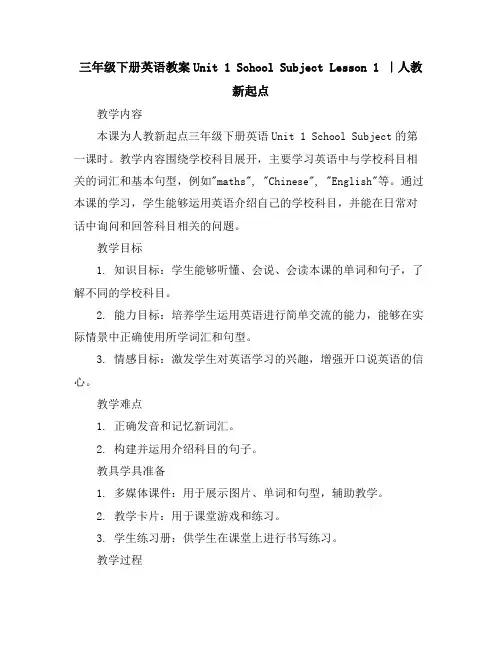
三年级下册英语教案Unit 1 School Subject Lesson 1 |人教新起点教学内容本课为人教新起点三年级下册英语Unit 1 School Subject的第一课时。
教学内容围绕学校科目展开,主要学习英语中与学校科目相关的词汇和基本句型,例如"maths", "Chinese", "English"等。
通过本课的学习,学生能够运用英语介绍自己的学校科目,并能在日常对话中询问和回答科目相关的问题。
教学目标1. 知识目标:学生能够听懂、会说、会读本课的单词和句子,了解不同的学校科目。
2. 能力目标:培养学生运用英语进行简单交流的能力,能够在实际情景中正确使用所学词汇和句型。
3. 情感目标:激发学生对英语学习的兴趣,增强开口说英语的信心。
教学难点1. 正确发音和记忆新词汇。
2. 构建并运用介绍科目的句子。
教具学具准备1. 多媒体课件:用于展示图片、单词和句型,辅助教学。
2. 教学卡片:用于课堂游戏和练习。
3. 学生练习册:供学生在课堂上进行书写练习。
教学过程1. 导入:通过歌曲或游戏的方式复习上学期学过的相关内容,引出新课主题。
2. 新课展示:利用多媒体课件展示本课的主要词汇和句型,通过图片和声音的结合,让学生在真实语境中感知和理解新知识。
3. 互动练习:组织学生进行角色扮演、小组对话等互动活动,让学生在实际操作中运用所学知识。
4. 巩固强化:通过游戏、竞赛等形式,巩固学生对新词汇和句型的掌握。
板书设计板书设计将简洁明了地展示本课的主要词汇和句型,方便学生跟随教学进度进行学习和复习。
作业设计1. 听力练习:听录音,选择正确的图片。
2. 口语练习:与家长或同学进行角色扮演,模拟课堂对话。
3. 书面练习:完成练习册上的相关练习。
课后反思课后反思将围绕学生的课堂表现、教学效果和教学方法的适用性进行。
针对学生的掌握情况,及时调整教学策略,以确保教学目标的实现。


Unit 1 Welcome back to school!教材分析本单元以同学们新学期开学重新回到校园为话题。教学内容是围绕国家、校园人物、自我介绍而展开的。教学重点是听、说、认读单词“China, Canada, UK, USA, he, she”和“teacher, student, pupil”及其复数形式。能听懂、会说核心句型“We have two new friends today.” “—Hi, I’m… I’m from… —Welcome!” “—Where are you from? —I’m from…” “He/She is…”。
教学目标知识目标:·能够听懂、会说句型“—Where are you from? —I’m from…” “He/She is…”·能够认读句子“—Where are you from? —I’m from…”·能够听、说、认读单词“China, Canada, UK, USA, he, she, teacher, student(pupil)”·知道元音字母a在单词中的短音发音/æ/能力目标:·能够在真实或模拟的情景中运用句型“I’m from…”“He’s/she’s a…”等简单介绍自己以及他人·能够在情景中运用句型“—Where are you from?—I’m from…”询问他人的国籍或籍贯并回答·能够正确说出元音字母a在单词中的短音发音/æ/,并能够根据其发音规则拼读学过的语音例词情感态度、文化意识、学习策略目标:·学会与人沟通、交流个人信息·学习对人有礼貌的好行为·通过学习国家名称,了解中国和主要英语国家的国旗以及标志性的建筑物·能够逐步做到见到符合发音规则的词能拼读,听到符合发音规则的词能拼写课时安排第一课时: Part A Let’s talk & Look and say第二课时: Part A Let’s learn & Let’s chant第三课时: Part A Let’s spell第四课时: Part B Let’s talk & Look and say第五课时: Part B Let’s learn & Let’s chant第六课时: Part B Start to read & Let’s check & Let’s singThe first period(第一课时)Part A Let’s talk & Look and say▶教学内容与目标课时教学内容课时教学目标Let’s talk ·通过观察、谈论Let’s talk板块的图片,并在PPT和教师的帮助下理解对话大意·能够按照正确的语音语调朗读对话,并能在小组中进行角色表演·能在情景中运用句型“We have two new friends today.” “Hi, I’m… I’m from…”进行初步的交流并介绍自己的国籍或籍贯Look and say ·通过教师展示的图片,操练核心句型“Hi, I’m… I’m from…”▶能够熟练运用句型“Hi, I’m… I’m from…”进行自我介绍。▶教学难点1.能够听懂对话大意,并能用正确的语音语调朗读对话。2.知道China, Canada的正确发音,知道国家名缩写UK和USA所表示的含义,并记住国家名缩写前必须带定冠词the。▶教学准备1.预习。2. PPT课件、课文录音、视频、人物头饰等。▶教学过程Step 1: Warm-up & Lead-in1.Greetings.T: Hello! Everyone. Welcome back to school! Nice to see youagain.Ss: Nice to see you, too.2.Sing a song—Hello. (播放课件)①3.Lead-in.T: Before the class, I’ll divide you into four groups. Group 1: China. Group 2: The UK. Group 3: Canada. Group 4: The USA. Let’s have a competition, OK?Ss: OK!Step 2: Presentation1.Look and learn.②T: Boys and girls, we have two new friends today. Let’s have a look! Teaching purpose①歌曲不仅可以激发学生的学习兴趣,还能帮助学生自然地进入学习英语的氛围中。Teaching purpose②利用学生熟悉的卡通形象自然导入,贴近学生实际生活。利用图片教学,使抽象知识具体化,更利于学生理解和掌握。(1)Panpan: Hello! I’m Panpan. I’m from China. Nice to see you!(课件出示:熊猫图片和五星红旗,并播放以上画外音,台词根据语音逐字出现)(2) Peppa Pig: H ello! I’m Peppa Pig. I’m from the UK. Nice to see you!(课件出示:小猪佩奇图片和英国国旗,并播放以上画外音,台词根据语音逐字出现)Teach the new words.T: Do you like your new friends?Ss: Yes.Write down the sentence “We have two new friends today.” on the blackboard (Write “new” and “friends” in red chalk.), and teach the words “new” and “friend(s)” in high and low voice.T: Do you still remember our old friends?Show the pictures of Chen Jie, Mike, Sarah, Wu Binbin and John on the PPT one by one.(出示课件)Lead students to introduce them by usi ng “Hi! I’m…”T: Well, they have two new friends today, too. Who are they?Show the pictures of Amy and Zhang Peng on the PPT. (出示课件) Teach the words “boy” and “girl” by pointing to different students on the PPT. Show the plural forms of “boy” and “girl” on the PPT. (出示课件)2.Watch and answer.③(1) Students watch the video. (课件出示:教材P4 Let’s talk的视频)T: So, can you answer the questions? You can look at your books. Brief answer is OK.S1: They are Amy and Zhang Peng.S2: Amy is from the UK and Zhang Peng is from Shandong.(2) Students watch again. The teacher shows the dialogue on thePPT, and circles the new words “and, today, welcome”. (出示课件) Show the meaning of these words on the PPT, and then teach the words. (出示课件)(Teaching methods: read one by one, group to group, boys vs girls, catch the finger.)3.Listen and repeat.④Teaching purpose③通过问题引导学生回忆课文视频并观察和讨论课文图片,整体感知文本内容,进入文本话题。多种游戏活动操练单词,增强趣味性。Teaching purpose④播放录音,学生听录音跟读。引导学生按照正确的语音语调朗读对话。小老师活动的设计能激发学生兴趣,鼓励学生,增强自信。(1) Let students read after the recording and pay attention to the pronunciation and the intonation. (出示课件)(2) Let students read the dialogue in groups.(3) Invite different students to be little teachers to lead the other students to read the new words for several times.4.Role-play.⑤Each group chooses one student to wear a headwear and role\|play.T: What’s your name, please?S1: I’m Amy.T: Where are you from?S1: I’m from the UK.T: Welcome! Now, introduce yourself to the class.S1: Hello! I’m Amy. I’m from the UK.Ss: Welcome!T: What’s your name, please?S2: I’m Zhang Peng.…The best group will be rewarded.Step 3: PracticeLook and say.⑥1.Play the recording of “Look and say”. (课件出示:教材P4 Look and say的音频)The teacher shows the dialogue on the PPT, and circles the words “Canada” and “the USA” as well as their flags on the PPT. (出示课件) Students read the words after the teacher.2.Read and match.Lead students to read and match, then let them introduce themselves by using the following sentence structures:I’m _______.I’m from (the) _______.3.Read and act.(1) Students practice the dialogue in groups and wear the head wears to act it out.(2) Students make their own dialogues, then show them to the class. Teaching purpose⑤通过戴头饰进行角色扮演,引导学生操练核心词汇及句型。Teaching purpose⑥在学习文本的基础上,让学生连线并且自我介绍,引导学生创编对话并进行操练,使学生易于掌握功能句型。Step 4: Consolidation & Extension⑦1.Train, train, train.Show a big map. (课件出示:世界地图) The teacher points to different cities or countries. Students are asked to introduce themselves one by one.For examples:(The teacher points to Beijing.)S1: Hi, I’m… I’m from Beijing.Ss: Welcome!(The teacher points to the UK.)S2: Hi, I’m… I’m from the UK.Ss: Welcome!…2.Dubbing Show.The teacher shows some pictures on the PPT like Ne Zha, Doraemon, Spiderman, Harry Potter and so on. Lead students to dub forthem by using the following sentences. (课件出示:哪吒、哆啦A梦、蜘蛛侠、哈利波特等照片)S1: Hello, I’m Ne Zha. I’m from China.S2: Hi, I’m Doraemon. I’m from Japan.…▶板书设计▶作业设计1. Practice the dialogues.2. Do the exercises. Teaching purpose⑦游戏活动设计与本课内容紧密相连,为学生创设真实的语境,让学生在轻松自然的氛围中学习。▶教学反思1.整个教学设计流程清晰,很好地达成了课程教学目标。2.活动设计丰富,易操作,由浅入深,层层深入,有效地提升了学生的核心素养。3.充分利用多媒体资源展开课堂教学。利用生动形象的图片、视频及课件来辅助教学,激发学生的学习兴趣。4.突出语用功能,通过创设合理的情景,帮助学生在情景中真实自然地使用所学语言。▶Teaching Contents & Teaching AimsLet’s talk·Be able to understand the main idea of the dialogue by observing and talking about the picture of “Let’s talk”.·Be able to read the dialogue with correct pronunciation and intonation, and be able to role\|play in groups.·Be able to use the sentence structures properly.Look and say·Be able to practice the sentence s tructures “Hi, I’m… I’m from…”▶Teaching Priorities·Be able to use the sentence structures “Hi, I’m… I’m from…” skillfully to introduce themselves.▶Teaching Difficulties·Be able to understand the dialogue and read it fluently and correctly.·Be able to master the pronunciation of “China” and “Canada”, as well as the meaning of “the UK” and “the USA”.▶Teaching Procedures。
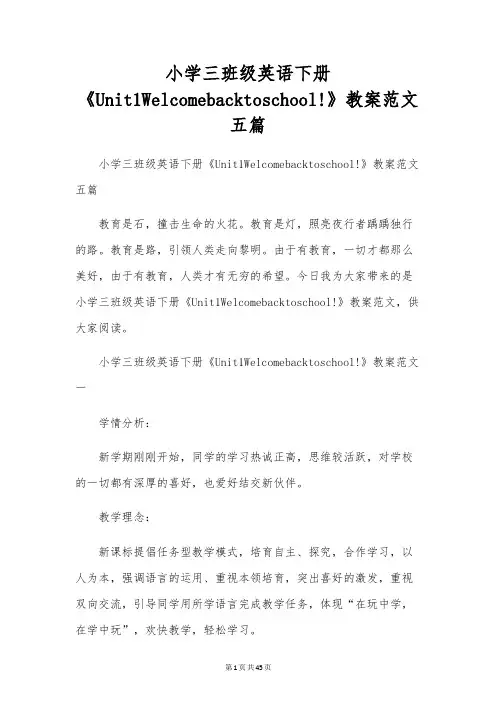
小学三班级英语下册《Unit1Welcomebacktoschool!》教案范文五篇小学三班级英语下册《Unit1Welcomebacktoschool!》教案范文五篇教育是石,撞击生命的火花。
教育是灯,照亮夜行者踽踽独行的路。
教育是路,引领人类走向黎明。
由于有教育,一切才都那么美好,由于有教育,人类才有无穷的希望。
今日我为大家带来的是小学三班级英语下册《Unit1Welcomebacktoschool!》教案范文,供大家阅读。
小学三班级英语下册《Unit1Welcomebacktoschool!》教案范文一学情分析:新学期刚刚开始,同学的学习热诚正高,思维较活跃,对学校的一切都有深厚的喜好,也爱好结交新伙伴。
教学理念:新课标提倡任务型教学模式,培育自主、探究,合作学习,以人为本,强调语言的运用、重视本领培育,突出喜好的激发,重视双向交流,引导同学用所学语言完成教学任务,体现“在玩中学,在学中玩”,欢快教学,轻松学习。
教学目标学问与技能:1、能听说单词Welcome,back,boy,and,girl,we,new,friend,today,from等;2、会运用句子Irsquo;m/Irsquo;mfrom介绍自身及自身的情况。
3、学习表示国家和省会名称的单词:UK,China (Shandong),USA,Canada过程与方法:创设情景,小组合作学习中巩固运用句型和单词。
情感、态度和价值观:培育同学敬重他人的良好品质,及团结友爱的精神。
重点:理解单词boy,girl,friend。
难点:1、boy和from的读音不易把握。
2、认得和理解英语中人名、地名及国家名称的写法和读法。
学法引导:同学活动教具学具国旗,头饰教学过程:Step1.Warmup/Revision师生共唱Hello,歌曲,让同学快速进入英语课堂。
师生问候,用英语打招呼Welcomebacktoschool!复习巩固学过的内容,介绍自身的姓名,创设英语学习氛围。
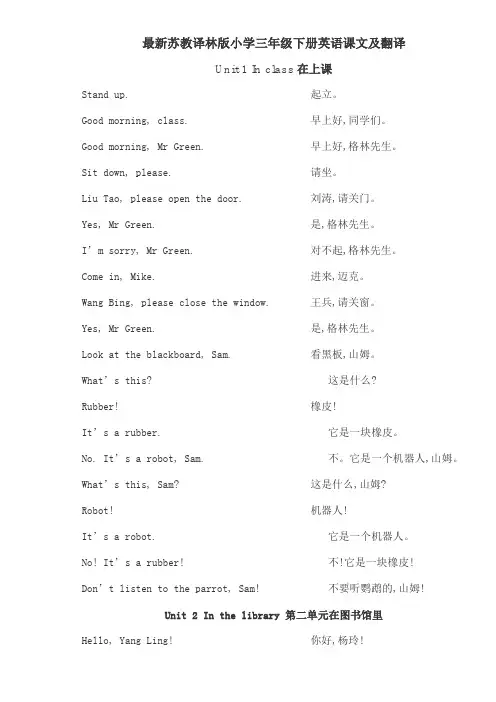
最新苏教译林版小学三年级下册英语课文及翻译Unit 1 In class在上课Stand up. 起立。
Good morning, class. 早上好,同学们。
Good morning, Mr Green. 早上好,格林先生。
Sit down, please. 请坐。
Liu Tao, please open the door. 刘涛,请关门。
Yes, Mr Green. 是,格林先生。
I’m sorry, Mr Green. 对不起,格林先生。
Come in, Mike. 进来,迈克。
Wang Bing, please close the window. 王兵,请关窗。
Yes, Mr Green. 是,格林先生。
Look at the blackboard, Sam. 看黑板,山姆。
What’s this? 这是什么?Rubber! 橡皮!It’s a rubber. 它是一块橡皮。
No. It’s a robot, Sam. 不。
它是一个机器人,山姆。
What’s this, Sam? 这是什么,山姆?Robot! 机器人!It’s a robot. 它是一个机器人。
No! It’s a rubber! 不!它是一块橡皮!Don’t listen to the parrot, Sam! 不要听鹦鹉的,山姆!Unit 2 In the library 第二单元在图书馆里Hello, Yang Ling! 你好,杨玲!Shh! Don’t shout, Liu Tao. 嘘!不要叫,刘涛。
Don’t run, Liu Tao. 不要跑,刘涛。
Would you like a sweet, Yang Ling? 你想要颗糖果吗,杨玲? No, thank you. 不要,谢谢。
Don’t eat h ere. 不要在这里吃东西。
Don’t shout. 不要叫。
Don’t run. 不要跑。
Don’t eat. 不要吃。
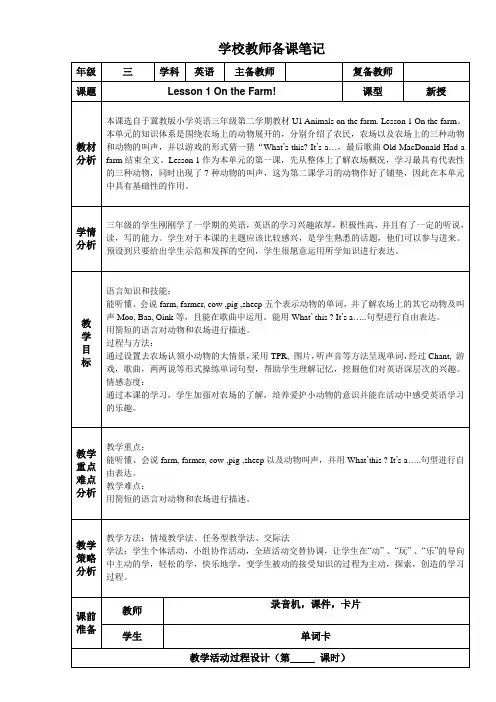
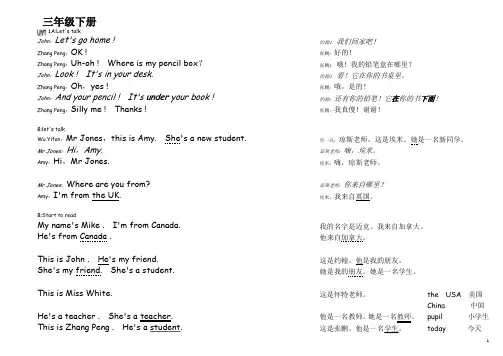
三年级下册Unit 1A:Let's talkJohn:Let's go home !Zhang Peng:OK !Zhang Peng:Uh-oh ! Where is my pencil box?John:Look ! It's in your desk.Zhang Peng:Oh,yes !John:And your pencil ! It's under your book ! Zhang Peng:Silly me ! Thanks !B:let's talkWu Yifan:Mr Jones,this is Amy. She's a new student. Mr Jones:Hi,Amy.Amy:Hi,Mr Jones.Mr Jones:Where are you from?Amy:I'm from the UK.B:Start to readMy name's Mike . I'm from Canada.He's from Canada .This is John . He's my friend.She's my friend. She's a student.This is Miss White.He's a teacher . She's a teacher.This is Zhang Peng . He's a student. 约翰:我们回家吧!张鹏:好的!张鹏:哦!我的铅笔盒在哪里?约翰:看!它在你的书桌里。
张鹏:哦,是的!约翰:还有你的铅笔!它在你的书下面!张鹏:我真傻!谢谢!吴一凡:琼斯老师,这是埃米。
她是一名新同学。
琼斯老师:嗨,埃米。
埃米:嗨,琼斯老师。
琼斯老师:你来自哪里?埃米:我来自英国。
我的名字是迈克。
我来自加拿大。
他来自加拿大。
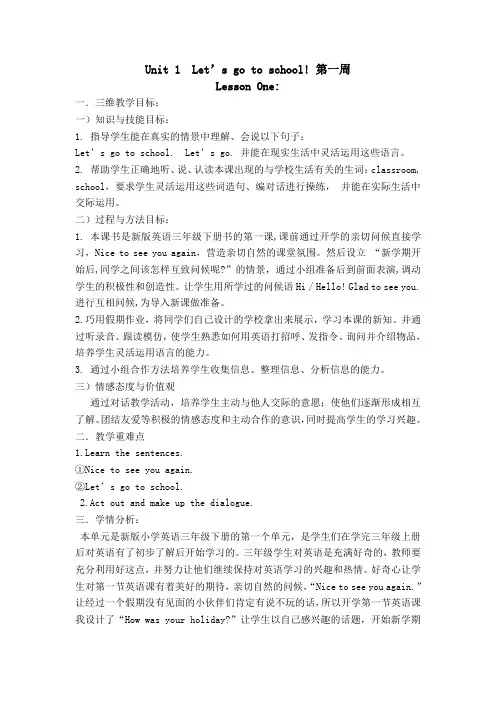
Unit 1 Let’s go to school! 第一周Lesson One:一.三维教学目标:一)知识与技能目标:1. 指导学生能在真实的情景中理解、会说以下句子:Let’s go to school. Let’s go. 并能在现实生活中灵活运用这些语言。
2. 帮助学生正确地听、说、认读本课出现的与学校生活有关的生词:classroom, school,要求学生灵活运用这些词造句、编对话进行操练,并能在实际生活中交际运用。
二)过程与方法目标:1. 本课书是新版英语三年级下册书的第一课,课前通过开学的亲切问候直接学习,Nice to see you again,营造亲切自然的课堂氛围。
然后设立“新学期开始后,同学之间该怎样互致问候呢?”的情景,通过小组准备后到前面表演,调动学生的积极性和创造性。
让学生用所学过的问候语Hi / Hello! Glad to see you.进行互相问候,为导入新课做准备。
2.巧用假期作业,将同学们自己设计的学校拿出来展示,学习本课的新知。
并通过听录音、跟读模仿,使学生熟悉如何用英语打招呼、发指令、询问并介绍物品,培养学生灵活运用语言的能力。
3. 通过小组合作方法培养学生收集信息、整理信息、分析信息的能力。
三)情感态度与价值观通过对话教学活动,培养学生主动与他人交际的意愿;使他们逐渐形成相互了解、团结友爱等积极的情感态度和主动合作的意识,同时提高学生的学习兴趣。
二.教学重难点1.Learn the sentences.①Nice to see you again.②Let’s go to school.2.Act out and make up the dialogue.三.学情分析:本单元是新版小学英语三年级下册的第一个单元,是学生们在学完三年级上册后对英语有了初步了解后开始学习的。
三年级学生对英语是充满好奇的,教师要充分利用好这点,并努力让他们继续保持对英语学习的兴趣和热情。
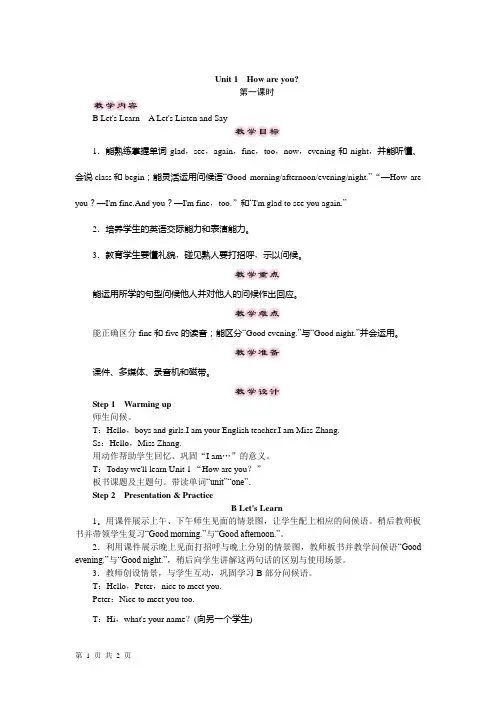
Unit 1How are you?第一课时B Let's Learn A Let's Listen and Say1.能熟练掌握单词glad,see,again,fine,too,now,evening和night,并能听懂、会说class和begin;能灵活运用问候语“Good morning/afternoon/evening/night.”“—How are you?—I'm fine.And you?—I'm fine,too.”和“I'm glad to see you again.”2.培养学生的英语交际能力和表演能力。
3.教育学生要懂礼貌,碰见熟人要打招呼,示以问候。
能运用所学的句型问候他人并对他人的问候作出回应。
能正确区分fine和five的读音;能区分“Good evening.”与“Good night.”并会运用。
课件、多媒体、录音机和磁带。
Step 1Warming up师生问候。
T:Hello,boys and girls.I am your English teacher.I am Miss Zhang.Ss:Hello,Miss Zhang.用动作帮助学生回忆、巩固“I am…”的意义。
T:Today we'll learn Unit 1 “How are you?”板书课题及主题句。
带读单词“unit”“one”.Step 2Presentation & PracticeB Let's Learn1.用课件展示上午、下午师生见面的情景图,让学生配上相应的问候语。
稍后教师板书并带领学生复习“Good morning.”与“Good afternoon.”。
2.利用课件展示晚上见面打招呼与晚上分别的情景图,教师板书并教学问候语“Good evening.”与“Good night.”,稍后向学生讲解这两句话的区别与使用场景。
PEP小学英语三年级下册Unit1 第一课设计教案:unit1Welcome back to school教材来源:小学三年级《英语》教科书/人民教育出版社2021版内容来源:小学三年级《英语(下册)》第一单元主题:Welcome back to school A Let’s learn 课时:共6课时,第1课时授课对象:三年级学生设计者:马燕菊目标确定的依据 1.课程标准相关要求能根据听到的词语识别或指认图片或实物;能根据录音模仿说英语;能根据图、文说出单词或短句。
能看图识字;能在指认物体的前提下认读所学词语。
2.教材和学情分析这是本单元第一课时。
主要学习四个国家的名称,以及介绍自己的姓名及国籍。
本节课教学内容比较简单,但是Canana、China两个单词的发音比较难,在授课时要注意学生的学习情况。
目标1.借助图片和录音,能正确听辨、认读UK, Canana, China, USA, 做到发音准确,元音清晰。
2.借助教师板书示范, 能写出以上4个单词,做到拼写正确、书写规范。
3.借助提示词和主句型,能对人物的国籍进行对话式描述,用词准确、表达完整、流畅。
评价任务1.借助卡片,指认听到的单词;认读卡片上的单词。
(检测目标1的达成情况)2.出示人物图片,让学生选择4个词汇中与其特征相匹配的单词进行国籍介绍和书写。
(检测目标2的达成情况)3.重复使用人物图片,让4-6个同桌或小组用所学词汇和主句型对人物国籍进行描述。
(检测目标3的达成情况)1教学过程Step I Revision出示一幅本册教材的几个人物的图片,提问:What’s her/his name? 学生作出回答。
StepⅡ Presentation1.识词(1)学习China由国旗图片引入国籍名称。
T: Oh ,hello , I’m Linda ,look here , tellme ,What’s this ? S: It’s a … T:It’s a flag.T: Do you know which contry’s flag is it? S: 中国T:Let’s listen to the tape three times ,let’s read it together .→教师板书单词于四线三格内,学生书空;T: show me your finger ,spell it together . S: c h i n aT:I’ll give you 1 minute to remember thisT: (to remember it by themselves ).T: Who can have a try ? spell it to us .(达成目标一) S: c h i n aT: Wonderful .OK ,show me your finger ,Let’s spell it together .(老师在黑板上写上单词).→播放录音,学生跟读、自读;教师提名请学生范读,要求读准元音发音;T:Now ,who can have a try to read it by yourselves?S: chinaT: Who can make his mistakes ? S:(学生纠正读错的音节)T: very good ,sit down ,please .Now ,follow me . china�J , china�K .ch i na 拆分音节。
三年级下册英语教案Unit 1 Lesson1人教精通教学内容本课为三年级下册英语教科书《人教精通》第一单元第一课,主要围绕日常生活中的基本英语用语进行教学。
教学内容涉及简单的问候语、介绍自己、表达感受等,同时还包括一些基础的英语单词和短语,如“morning”、“afternoon”、“evening”、“hello”、“my name is”等。
教学目标1. 让学生掌握基本的英语问候语,能够用英语进行简单的日常交流。
2. 培养学生的英语听说能力,提高他们的英语口语表达能力。
3. 让学生掌握一些基础的英语单词和短语,能够正确运用到日常生活中。
教学难点1. 英语问候语的使用和应答。
2. 自我介绍的表达方式。
3. 英语单词和短语的正确发音和书写。
教具学具准备1. 英语教科书《人教精通》。
2. 多媒体设备,用于播放英语教学视频和音频。
3. 英语单词卡片,用于辅助教学。
4. 黑板和粉笔,用于板书设计。
教学过程1. 导入:通过播放英语问候语的音频,引起学生的兴趣,让学生初步感知英语的语音和语调。
2. 新授:通过展示英语单词卡片,教授学生新的单词和短语,让学生跟读并模仿。
3. 练习:通过设计一些简单的英语对话,让学生进行角色扮演,练习使用所学的英语问候语和自我介绍的表达方式。
4. 巩固:通过播放英语教学视频,让学生观看并跟读,巩固所学的英语单词和短语。
板书设计1. Unit 1 Lesson 1 Greetings and Introductions2. 内容:问候语:morning, afternoon, evening, hello自我介绍:my name is表达感受:happy, sad, tired, excited作业设计1. 听:听英语问候语的音频,跟读并模仿。
2. 说:用英语进行自我介绍,并练习使用所学的英语问候语。
3. 读:阅读教科书中的英语对话,理解并模仿。
4. 写:抄写所学的英语单词和短语,熟悉其书写。
人教版小学英语课文内容及翻译三年级下册Unit 1 Welcome back to schoolA Let’s talkGood morning,boys and girls!早上好。
同学们。
Good morning,Miss White.早上好,Miss White。
Class, we have a new friend today.同学们,今天我们有一个新朋友。
Hi!I’m Amy. I’m from America.你们好。
我是Amy。
我来自美国。
Welcome!欢迎!Let’s learnboy 男孩girl女孩watch out!小心!Oh,no!啊!不!Let’s sayapple苹果ant蚂蚁boy 男孩bag书包Coke可乐coffee咖啡B Let’s talkGood afternoon.下午好!Good afternoon。
Mr Black.下午好!Mr Black。
This is my friend, Amy。
这是我的朋友,Amy。
Nice to meet you。
认识你很高兴。
Nice to meet you,too.认识你也很高兴。
Where are you from?你从哪里来?I’m from America.我是美国人。
Goodbye, Mr Black.再见Mr Black。
Goodbye.再见!Let’s learnboy 男孩girl女孩Come in进来。
I’m sorry。
对不起。
It’s OK. 没关系.Let’s saydog 狗duck鸭子egg蛋elephant大象Let’s doA A A,say ‘OK!’B B B , touch your knee.C C C ,look and see。
D D D , make a “D”E E E ,drink some tea。
A B C D E ,come and follow me。
Unit 2 My familyA Let’s talkWho’s that woman?那个女人是谁?She’s my mother.她是我妈妈.Who's that man?那个男人是谁?He’s my father.他是我爸爸。
三年级下册冀教版英语第一课In the third grade, students embark on a new journey of English learning, and the first lesson of the term plays a pivotal role in setting the tone for their language skills. The冀教版 English textbook for the third grade, lower semester, introduces students to the basics of the language in a fun and engaging manner.The lesson begins with greetings and introductions, teaching students how to say "Hello" and introduce themselves in English. This simple yet crucial conversation starter lays the foundation for further communication and interaction in the language. As students progress through the lesson, they learn about different objects and their corresponding English names. This helps them associatereal-world items with their English equivalents, making the language more relatable and practical.The lesson also introduces basic vocabulary related to school life, such as "classroom," "teacher," and "student." This vocabulary is not only relevant to the students' daily lives but also helps them understand the English languagein a contextual manner. By relating the new vocabulary tofamiliar settings and situations, the lesson makes learning more meaningful and enjoyable.To further enhance the learning experience, the lesson includes various activities and games that engage students actively. These activities range from simple speaking exercises to more interactive role-playing games, allowing students to practice their English skills in a fun and dynamic environment. These activities not only improve students' language proficiency but also foster a positive attitude towards learning English.The冀教版 English textbook also emphasizes the importance of visual aids and illustrations in aiding learning. The lesson is accompanied by colorful images and diagrams that help students visualize the new vocabulary and concepts. This visual stimulation not only makes learning more engaging but also helps students retain information better.In addition to the basic language skills, the lesson also focuses on developing students' cultural awareness. It introduces them to basic etiquette and greetings inEnglish-speaking countries, helping them understand theimportance of respecting cultural differences. This focus on cultural understanding complements the language learning and prepares students for real-world interactions with people from different backgrounds.The third grade is a crucial phase in students' language development, and the first lesson of the冀教版English textbook for the lower semester sets the stage for successful English learning. By introducing students to the basics of the language in a fun and engaging manner, the lesson fosters a positive attitude towards learning that will carry them through their English learning journey. As students progress through the term, they will build upon the foundation laid in this first lesson, developing their language skills and cultural understanding to new heights. **冀教版三年级下册英语第一课:英语学习新篇章的开启** 三年级的学生们迎来了英语学习的新篇章,而本学期的第一课对于他们的语言技能发展具有举足轻重的意义。
人教版小学英语三年级下册Unit1 School教课设计设计教课目的1.可以对英语学习产生初步的兴趣并踊跃参加讲堂上的各样活动。
2.可以在本单元波及的情形中认识并能说出四个主线人物的名字:Bill,Lily,Andy和Joy, 认识宠物狗 Lucky和主线人物的好朋友 Angel. 3.可以在教材供给的情形入耳懂相关文具的词汇,并初步说出这些单词。
4.可以听懂并能使用问候语Good morning, 会曲稿单元的歌曲。
5.可以听懂讲堂指令语 stand up 等,并做出正确的反响。
6.可以听懂本单元的歌谣,并会用歌谣做自我介绍。
第一课时一、课前准备1.教课挂图2.教课多媒体光盘3.实物:大书,长铅笔,长尺子和大橡皮二、教课内容A look listen and chant1.经过对话引入歌谣学习相关文具及学校的五个英文单词。
2.文字不要修业生掌握,只需求能听懂。
B let ’ s say学习怎样问清晨好。
三、教课过程(一)导入T:欢迎小朋友们来学校学习,在学校里我们认识了佷多新朋友,想不想再多些朋友呀?S:想 !T:出示挂图,介绍四位主线人物并问图中小朋友在干什么?大体在说什么?S:他们在说英语,他们在校园里用英语打招呼。
T:对 ! 他们正是在用英语“清晨好”打招呼。
(二)新授1.师生在相互打招呼的过程中练习要点句Good morning!2.Chant的学习*经过实物大书,长铅笔,长尺子,大橡皮的演示加深对词汇的理解。
*注意培育学生感觉 Chant的节奏,拍手或做动作随着录音说唱。
3.鼓舞学生替代 Chant中的词汇,自编 Chant(三)小结1.两个同学用自编的 Chant做练习或一人说,多人做出动作。
2.Song: 歌曲 <</span>Hello,how are you?>四、作业1.学会了问“清晨好”,但是到了下午和夜晚怎么问候呢?下次课上能用什么希望学吗?五、板书:Unit1 Schoolschool pencil book ruler schoolbag第二課一、前准1.教课挂,卡2.教课多媒体光二、教课内容A.Listen, do and say1.学交用“ Hello ” , 并学会介自己,如 I ‘m⋯.2.学生感知堂用 Stand up ! Sit down !3.学生 TPR Show me⋯B.Let ’s act and sing.1.A部分内容的操作。
闽教版小学英语三年级下册全册课文Unit 1 BirthdayPart APlease come to my birthday party. 请大家来参加我的生日派对。
Let’s buy a present. (让)我们去买个礼物吧。
And a birthday card. 还要买一张生日贺卡。
What about a football? 买一个足球怎么样?Oh, no! 哦,不行!What about a rabbit? 买一只兔子怎么样?Good ideal. 好主意!巩固练习Let’s buy a present.What about a ?Good ideal.Pencil-box ruler bag rabbit pen football card笔盒尺子书包兔子钢笔足球贺卡,卡片Part BHappy birthday, Sally! 生日快乐,莎莉!Here’s a present for you. 送你一个礼物。
Oh, thank you! 谢谢!What’s this? A bird? 这是什么?一只鸟?No. 不是。
Oh! It’s a rabbit. Thank you. 哦!是一只兔子。
谢谢你们。
句型巩固:What’s this?这是什么?It’s an orange。
这是一个橘子。
Part C学习写生日贺卡Happy birthday!例:Dear Sally,Happy birthday, my dear friend, may you be happy every day!from BettyUnit 2 Ability(能力)Part AI can dance. 我会跳舞。
I can dance, too. 我也会跳舞。
I can swim. 我会游泳。
I can swim, too. 我也会游泳。
I can draw. 我会画画。
I can draw, too. 我也会画画。